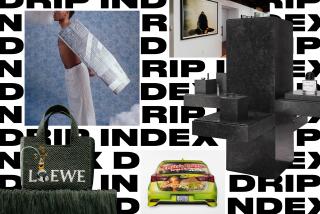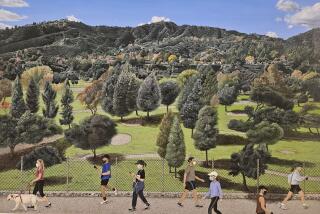No limits on Freewaves fest
“TOO Much Freedom?,” the 10th incarnation of Freewaves’ biennial festival of film, video and new media, kicked off last weekend at the UCLA Hammer Museum with a sprawling installation of projections and monitors that transformed the museum’s lobby and upper and lower courtyard space into a massive den of moving imagery. Though up for only two nights -- Friday and Saturday -- it was an impressively orchestrated presentation made all the more appealing by the consistently high caliber of its more than 100 works. (A scaled-down selection of works continues at the Hammer’s video library and viewing room through November.)
The field of media arts has changed tremendously in the 17 years since Freewaves was launched, and the festival’s format has continued to shift accordingly. This year’s lineup is bigger than last year’s, with about 170 works, and more geographically diverse than ever, with more than half the artists hailing from outside the United States. The schedule, however, has been significantly streamlined. Besides the Hammer installation and an exhibition that opened Saturday at the Pomona College Museum of Art (two recent video works by Austrian artist Oliver Ressler), the only other scheduled events are a book signing at LACE on Saturday and a screening of youth videos the following weekend at the National Center for the Preservation of Democracy.
The main attraction this year is not a specific event but a slick new website (www.freewaves.org) containing viewable full-length versions of nearly all the works, as well as information on the artists and, in many cases, e-mail addresses where you can contact them directly. Intended to function, according to the festival’s press materials, “as a fluid exhibition space and distribution channel with global reach and content,” the site is a welcome solution to the perennial problem of video presentation, and a fitting response to the increasingly international nature of the field.
The website isn’t without its quirks (I had trouble with the snazzy “Videos” page and found it easier to access the works through the straightforward but apparently still under-construction “Artists” page, though I’m told that one will have better luck with a Mac than a PC), nor is the space of a computer screen an ideal venue for many of these works. On the whole, however, the site offers an unusual opportunity to view a significant range of high-quality works from all over the world at any time.
THE title of this year’s festival, “Too Much Freedom?,” is a paraphrase of a remark made in 1999 by George W. Bush, then governor of Texas, when asked what he thought of a satirical website established by a group of artists known as the Yes Men. (His actual words were: “There ought to be limits to freedom.”) The question was posed in the festival’s call for entries, but no more specific theme was articulated.
Judging from the works that were chosen from the 1,800 submitted, the response was tremendously varied. Most of the pieces included have a political tone -- or something that, in the right context, could be interpreted as such -- but there are surprisingly few that feel at all didactic. What emerges throughout is not any particular leaning or stance but simply a heightened concern with the state of the world generally.
On the more obviously political end of the spectrum, one of the highlights is Israeli artist Avi Mograbi’s “Details 2 and 3,” which presents a pair of heated episodes between the artist, who is outside the shot (presumably holding the camera), and small groups of young soldiers at two Israeli checkpoints. Although the cause of each dispute is relatively minor, the language in which they unfold is revealing, pointing to the complex nature of military power relations and the deep reserves of tension, anxiety, presumption and fear that underscore even the most basic interaction in a time of heightened political conflict.
Another powerfully unsettling piece is the three-part “Pastan,” by Kazakh artist Erbosyn Meldibekov, in which we see an older man repeatedly slapping a younger man in the face, first in the privacy of a closed studio, then in public, surrounded by curiously passive onlookers. The slaps do not appear to be simulated, and the younger man takes them without protest or even much of an expression, which makes it exceptionally painful to watch.
On the more poetic end of the spectrum is a beautiful seven-minute animation by American artist Hillary Mushkin called “As We Go On,” Mary Magsamen and Stephan Hillerbrand’s cozily psychedelic “Coffee and Milk,” and a heartbreaking little piece by Norwegian artist Eva Drangsholt called “Icarus,” which depicts a middle-aged man, big-bellied and nude, running in a circle on a grass lawn, flapping his arms as if desperately hoping to take flight. (Interestingly, the latter piece was one of several videos censored by YouTube when Freewaves attempted to upload a selection onto that site, the organizers say.)
These are just a few of the many works worth mentioning. As the design of the Hammer installation seemed to acknowledge, however, there is more here than it would be possible to take in at once, so you’ll just have to trust your own rambling way through it. With the website online indefinitely, there is fortunately plenty of time.
*
L.A. Freewaves
Exhibitions
* “Too Much Freedom?” website: www.freewaves.org
* Selections from “Too Much Freedom?,” UCLA Hammer Museum Video Library and Viewing Room, 10899 Wilshire Blvd., L.A., (310) 443-7000. 11 a.m. to 7 p.m. Tuesdays, Wednesdays, Fridays, Saturdays; 11 a.m. to 9 p.m. Thursdays; 11 a.m. to 5 p.m. Sundays. Closed Mondays. Ends Nov. 30.
* “LA Freewaves: New Videos by Oliver Ressler,” Pomona College Museum of Art, Montgomery Art Center, 333 N. College Way, Claremont, (909) 621-8283. Noon to 5 p.m. Tuesdays through Fridays; 1 to 5 p.m. Saturdays, Sundays. Closed Mondays. Ends Dec. 17.
Events
* Discussion, screening and reception with artists and curators. LACE, 6522 Hollywood Blvd., L.A., (323) 957-1777. 8 p.m. Saturday.
* “Media That Matters” sixth touring festival and other youth videos. National Center for the Preservation of Democracy, 111 N. Central Ave., L.A., (213) 830-1880. 2 to 4 p.m. Nov. 18.
More to Read
The biggest entertainment stories
Get our big stories about Hollywood, film, television, music, arts, culture and more right in your inbox as soon as they publish.
You may occasionally receive promotional content from the Los Angeles Times.










